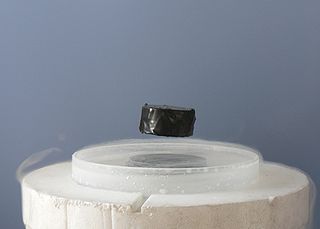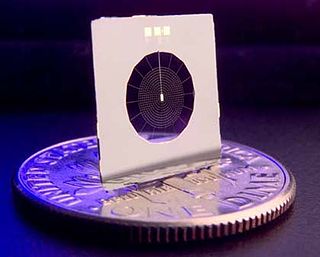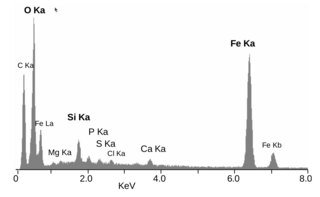
A transition-edge sensor (TES) is a type of cryogenic energy sensor or cryogenic particle detector that exploits the strongly temperature-dependent resistance of the superconducting phase transition.

A transition-edge sensor (TES) is a type of cryogenic energy sensor or cryogenic particle detector that exploits the strongly temperature-dependent resistance of the superconducting phase transition.
The first demonstrations of the superconducting transition's measurement potential appeared in the 1940s, 30 years after Onnes's discovery of superconductivity. D. H. Andrews demonstrated the first transition-edge bolometer, a current-biased tantalum wire which he used to measure an infrared signal. Subsequently he demonstrated a transition-edge calorimeter made of niobium nitride which was used to measure alpha particles. [1] However, the TES detector did not gain popularity for about 50 years, due primarily to the difficulty in stabilizing the temperature within the narrow superconducting transition region, especially when more than one pixel was operated at the same time, and also due to the difficulty of signal readout from such a low-impedance system. Joule heating in a current-biased TES can lead to thermal runaway that drives the detector into the normal (non-superconducting) state, a phenomenon known as positive electrothermal feedback. The thermal runaway problem was solved in 1995 by K. D. Irwin by voltage-biasing the TES, establishing stable negative electrothermal feedback, and coupling them to superconducting quantum interference devices (SQUID) current amplifiers. [2] This breakthrough has led to widespread adoption of TES detectors. [3]

The TES is voltage-biased by driving a current source Ibias through a load resistor RL (see figure). The voltage is chosen to put the TES in its so-called "self-biased region" where the power dissipated in the device is constant with the applied voltage. When a photon is absorbed by the TES, this extra power is removed by negative electrothermal feedback: the TES resistance increases, causing a drop in TES current; the Joule power in turn drops, cooling the device back to its equilibrium state in the self-biased region. In a common SQUID readout system, the TES is operated in series with the input coil L, which is inductively coupled to a SQUID series-array. Thus a change in TES current manifests as a change in the input flux to the SQUID, whose output is further amplified and read by room-temperature electronics.
Any bolometric sensor employs three basic components: an absorber of incident energy, a thermometer for measuring this energy, and a thermal link to base temperature to dissipate the absorbed energy and cool the detector. [4]
The simplest absorption scheme can be applied to TESs operating in the near-IR, optical, and UV regimes. These devices generally utilize a tungsten TES as its own absorber, which absorbs up to 20% of the incident radiation. [5] If high-efficiency detection is desired, the TES may be fabricated in a multi-layer optical cavity tuned to the desired operating wavelength and employing a backside mirror and frontside anti-reflection coating. Such techniques can decrease the transmission and reflection from the detectors to negligibly low values; 95% detection efficiency has been observed. [4] At higher energies, the primary obstacle to absorption is transmission, not reflection, and thus an absorber with high photon stopping power and low heat capacity is desirable; a bismuth film is often employed. [3] Any absorber should have low heat capacity with respect to the TES. Higher heat capacity in the absorber will contribute to noise and decrease the sensitivity of the detector (since a given absorbed energy will not produce as large of a change in TES resistance). For far-IR radiation into the millimeter range, the absorption schemes commonly employ antennas or feedhorns. [3]
The TES operates as a thermometer in the following manner: absorbed incident energy increases the resistance of the voltage-biased sensor within its transition region, and the integral of the resulting drop in current is proportional to the energy absorbed by the detector. [5] The output signal is proportional to the temperature change of the absorber, and thus for maximal sensitivity, a TES should have low heat capacity and a narrow transition. Important TES properties including not only heat capacity but also thermal conductance are strongly temperature dependent, so the choice of transition temperature Tc is critical to the device design. Furthermore, Tc should be chosen to accommodate the available cryogenic system. Tungsten has been a popular choice for elemental TESs as thin-film tungsten displays two phases, one with Tc ~15 mK and the other with Tc ~1–4 K, which can be combined to finely tune the overall device Tc. [6] Bilayer and multilayer TESs are another popular fabrication approach, where thin films of different materials are combined to achieve the desired Tc. [3]
Finally, it is necessary to tune the thermal coupling between the TES and the bath of cooling liquid; a low thermal conductance is necessary to ensure that incident energy is seen by the TES rather than being lost directly to the bath. However, the thermal link must not be too weak, as it is necessary to cool the TES back to bath temperature after the energy has been absorbed. Two approaches to control the thermal link are by electron–phonon coupling and by mechanical machining. At cryogenic temperatures, the electron and phonon systems in a material can become only weakly coupled. The electron–phonon thermal conductance is strongly temperature-dependent, and hence the thermal conductance can be tuned by adjusting Tc. [3] [4] Other devices use mechanical means of controlling the thermal conductance such as building the TES on a sub-micrometre membrane over a hole in the substrate or in the middle of a sparse "spiderweb" structure. [7]
TES detectors are attractive to the scientific community for a variety of reasons. Among their most striking attributes are an unprecedented high detection efficiency customizable to wavelengths from the millimeter regime to gamma rays [3] [4] and a theoretical negligible background dark count level (less than 1 event in 1000 s from intrinsic thermal fluctuations of the device [5] ). (In practice, although only a real energy signal will create a current pulse, a nonzero background level may be registered by the counting algorithm or the presence of background light in the experimental setup. Even thermal blackbody radiation may be seen by a TES optimized for use in the visible regime.)
TES single-photon detectors suffer nonetheless from a few disadvantages as compared to their avalanche photodiode (APD) counterparts. APDs are manufactured in small modules, which count photons out-of-the-box with a dead time of a few nanoseconds and output a pulse corresponding to each photon with a jitter of tens of picoseconds. In contrast, TES detectors must be operated in a cryogenic environment, output a signal that must be further analyzed to identify photons, and have a jitter of approximately 100 ns. [4] Furthermore, a single-photon spike on a TES detector lasts on the order of microseconds.
TES arrays are becoming increasingly common in physics and astronomy experiments such as SCUBA-2, the HAWC+ instrument on the Stratospheric Observatory for Infrared Astronomy, the Atacama Cosmology Telescope, the Cryogenic Dark Matter Search, the Cryogenic Rare Event Search with Superconducting Thermometers, the E and B Experiment, the South Pole Telescope, the Spider polarimeter, the X-IFU instrument of the Advanced Telescope for High Energy Astrophysics satellite, the future LiteBIRD Cosmic Microwave Background polarization experiment, the Simons Observatory, and the CMB Stage-IV Experiment.
| Wikimedia Commons has media related to Transition edge sensor . |

Superconductivity is a set of physical properties observed in certain materials where electrical resistance vanishes and magnetic flux fields are expelled from the material. Any material exhibiting these properties is a superconductor. Unlike an ordinary metallic conductor, whose resistance decreases gradually as its temperature is lowered even down to near absolute zero, a superconductor has a characteristic critical temperature below which the resistance drops abruptly to zero. An electric current through a loop of superconducting wire can persist indefinitely with no power source.

A SQUID is a very sensitive magnetometer used to measure extremely subtle magnetic fields, based on superconducting loops containing Josephson junctions.
Some of the technological applications of superconductivity include:

A bolometer is a device for measuring the power of incident electromagnetic radiation via the heating of a material with a temperature-dependent electrical resistance. It was invented in 1878 by the American astronomer Samuel Pierpont Langley.

A thermographic camera is a device that creates an image using infrared radiation, similar to a common camera that forms an image using visible light. Instead of the 400–700 nanometre range of the visible light camera, infrared cameras are sensitive to wavelengths from about 1,000 nm (1 μm) to about 14,000 nm (14 μm). The practice of capturing and analyzing the data they provide is called thermography.

Energy-dispersive X-ray spectroscopy, sometimes called energy dispersive X-ray analysis (EDXA) or energy dispersive X-ray microanalysis (EDXMA), is an analytical technique used for the elemental analysis or chemical characterization of a sample. It relies on an interaction of some source of X-ray excitation and a sample. Its characterization capabilities are due in large part to the fundamental principle that each element has a unique atomic structure allowing a unique set of peaks on its electromagnetic emission spectrum. The peak positions are predicted by the Moseley's law with accuracy much better than experimental resolution of a typical EDX instrument.

Photodetectors, also called photosensors, are sensors of light or other electromagnetic radiation. A photo detector has a p–n junction that converts light photons into current. The absorbed photons make electron–hole pairs in the depletion region. Photodiodes and photo transistors are a few examples of photo detectors. Solar cells convert some of the light energy absorbed into electrical energy.
The Cryogenic Dark Matter Search (CDMS) is a series of experiments designed to directly detect particle dark matter in the form of Weakly Interacting Massive Particles. Using an array of semiconductor detectors at millikelvin temperatures, CDMS has at times set the most sensitive limits on the interactions of WIMP dark matter with terrestrial materials. The first experiment, CDMS I, was run in a tunnel under the Stanford University campus. It was followed by CDMS II experiment in the Soudan Mine. The most recent experiment, SuperCDMS, was located deep underground in the Soudan Mine in northern Minnesota and collected data from 2011 through 2015. The series of experiments continues with SuperCDMS SNOLAB, an experiment located at the SNOLAB facility near Sudbury, Ontario in Canada that started construction in 2018 and is expected to start data taking in early 2020s.
A microbolometer is a specific type of bolometer used as a detector in a thermal camera. Infrared radiation with wavelengths between 7.5–14 μm strikes the detector material, heating it, and thus changing its electrical resistance. This resistance change is measured and processed into temperatures which can be used to create an image. Unlike other types of infrared detecting equipment, microbolometers do not require cooling.
Cryogenic particle detectors operate at very low temperature, typically only a few degrees above absolute zero. These sensors interact with an energetic elementary particle and deliver a signal that can be related to the type of particle and the nature of the interaction. While many types of particle detectors might be operated with improved performance at cryogenic temperatures, this term generally refers to types that take advantage of special effects or properties occurring only at low temperature.

Niobium nitride is a compound of niobium and nitrogen (nitride) with the chemical formula NbN. At low temperatures NbN becomes a superconductor, and is used in detectors for infrared light.

The Cryogenic Rare Event Search with Superconducting Thermometers (CRESST) is a collaboration of European experimental particle physics groups involved in the construction of cryogenic detectors for direct dark matter searches. The participating institutes are the Max Planck Institute for Physics (Munich), Technical University of Munich, University of Tübingen (Germany), University of Oxford and the Istituto Nazionale di Fisica Nucleare.
The superconducting tunnel junction (STJ) — also known as a superconductor–insulator–superconductor tunnel junction (SIS) — is an electronic device consisting of two superconductors separated by a very thin layer of insulating material. Current passes through the junction via the process of quantum tunneling. The STJ is a type of Josephson junction, though not all the properties of the STJ are described by the Josephson effect.

A Quantum Well Infrared Photodetector (QWIP) is an infrared photodetector, which uses electronic intersubband transitions in quantum wells to absorb photons. In order to be used for infrared detection, the parameters of the quantum wells in the quantum well infrared photodetector are adjusted so that the energy difference between its first and second quantized states match the incoming infrared photon energy. QWIPs are typically made of gallium arsenide, a material commonly found in smartphones and high-speed communications equipment. Depending on the material and the design of the quantum wells, the energy levels of the QWIP can be tailored to absorb radiation in the infrared region from 3 to 20 µm.

A measuring instrument is a device for measuring a physical quantity. In the physical sciences, quality assurance, and engineering, measurement is the activity of obtaining and comparing physical quantities of real-world objects and events. Established standard objects and events are used as units, and the process of measurement gives a number relating the item under study and the referenced unit of measurement. Measuring instruments, and formal test methods which define the instrument's use, are the means by which these relations of numbers are obtained. All measuring instruments are subject to varying degrees of instrument error and measurement uncertainty. These instruments may range from simple objects such as rulers and stopwatches to electron microscopes and particle accelerators. Virtual instrumentation is widely used in the development of modern measuring instruments.
Phonon noise, also known as thermal fluctuation noise, arises from the random exchange of energy between a thermal mass and its surrounding environment. This energy is quantized in the form of phonons. Each phonon has an energy of order , where is Boltzmann's constant and is the temperature. The random exchange of energy leads to fluctuations in temperature. This occurs even when the thermal mass and the environment are in thermal equilibrium, i.e. at the same time-average temperature. If a device has a temperature-dependent electrical resistance, then these fluctuations in temperature lead to fluctuations in resistance. Examples of devices where phonon noise is important include bolometers and calorimeters. The superconducting transition edge sensor (TES), which can be operated either as a bolometer or a calorimeter, is an example of a device for which phonon noise can significantly contribute to the total noise.

The kinetic inductance detector (KID) — also known as a microwave kinetic inductance detector (MKID) — is a type of superconducting photon detector first developed by scientists at the California Institute of Technology and the Jet Propulsion Laboratory in 2003. These devices operate at cryogenic temperatures, typically below 1 kelvin. They are being developed for high-sensitivity astronomical detection for frequencies ranging from the far-infrared to X-rays.

The superconducting nanowire single-photon detector (SNSPD) is a type of near-infrared and optical single-photon detector based on a current-biased superconducting nanowire. It was first developed by scientists at Moscow State Pedagogical University and at the University of Rochester in 2001. The first fully operational prototype was demonstrated in 2005 by the University of Rochester, the National Institute of Standards and Technology (Boulder), and BBN Technologies as part of the DARPA Quantum Network.
In electronics, electrothermal feedback is the interaction of the electric current and the temperature in a device with a temperature-dependent electrical resistance. This interaction arises from Joule heating.